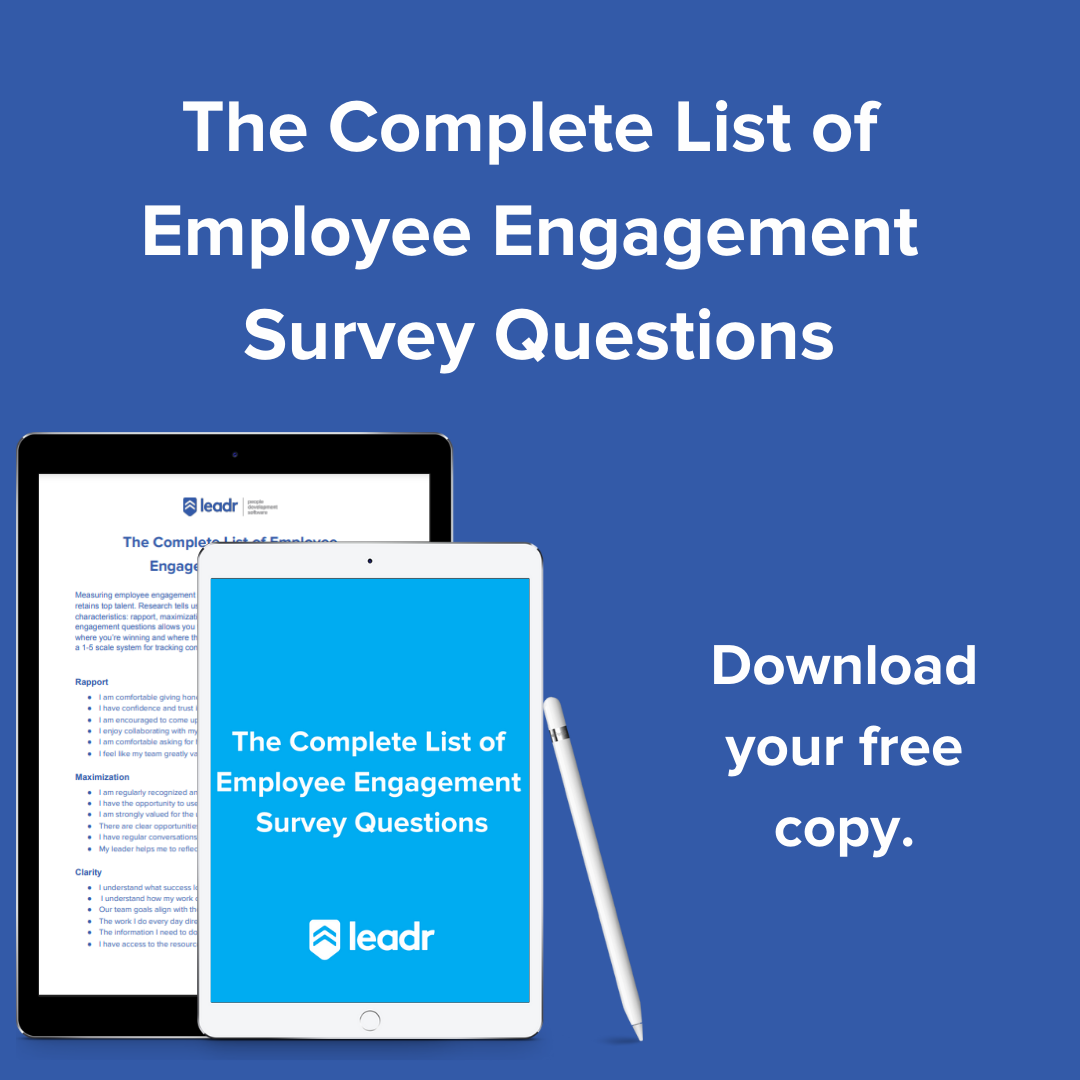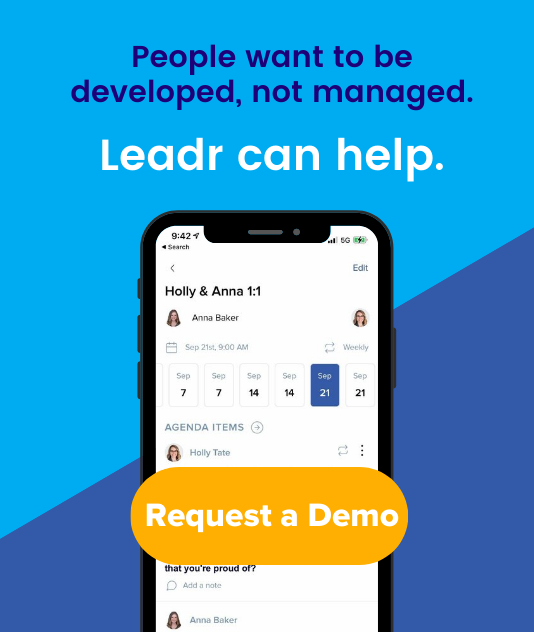If you have been poking around the leadership and people development world for any length of time, you’ve probably heard about the wonder that is 1:1 meetings. They’re the most important meeting. They put the employee in the driver’s seat. They are a crucial component of effective leadership.
This all sounds great, but if you're new to one-to-one meetings, getting started can feel overwhelming. What do you talk about? How often do you hold them? How long should they be? Who directs the meeting?
These are great questions. Before we dive into the nitty-gritty, let’s consider the purpose of one-to-one meetings.
The driving principles behind these meetings is voice, connection, and alignment. At Leadr, we have our direct reports lead most of their 1:1 meetings. We believe it’s our role, as leaders, to set them up for success. If you spend the whole meeting instructing and assigning new projects, you are not holding a 1:1 meeting, you are holding a project meeting. Instead, a 1:1 meeting should be a chance for you to help your team members develop and grow.
Now that we’ve covered the why, let’s look into the how. Here are some things to consider as you begin implementing regular one-to-one meetings with your direct reports.
Cadence
Each organization will have a unique cadence that works for them based on a number of factors, such as the number of direct reports.
DO: Schedule one-to-one meetings on a weekly or bi-weekly basis.
While other meetings may only need to happen once a month or once a quarter, 1:1 meetings work best when they are scheduled on a weekly or bi-weekly basis. Any longer between meetings and you risk losing touch with your team.
DON’T: Pack your schedule with 1:1 meetings.
If you find that your calendar is filled with one-to-one meetings, it might be time to reassess your organizational structure to ensure that every person on your team is getting the attention and development that they need to be successful.
DO: Determine a cadence and stick to it.
Getting into the habit of one-to-one meetings can be challenging. It can be tempting to put off a 1:1 meeting when things get busy or last-minute priorities arise, but these meetings form the foundation for development and feedback and should be non-negotiable. Tyranny of the urgent will always be a reality. Your people are always your priority.
DON’T: Only meet when you have questions or new initiatives.
As busy as your schedule can get it can be tempting to hold off on one-to-one meetings until problems arise. But if you only meet when something is wrong, you have missed an opportunity to create the trust and open communication that are necessary to effectively address problems when they do arise.
Timeframe
Once you have figured out how often to hold one-to-one meetings, the next consideration is the length of each meeting. You need enough time to cover everything while not feeling like it is an unproductive time-sink.
DO: Try a few meetings and adjust.
Still lost? Start with 45 minutes and adjust as needed. One of the hallmarks of one-to-one meetings is feedback. After you have held a few meetings, ask your direct reports for feedback about the structure of your meetings. Are they too long? Too short? Adjust as necessary until you have found a length that works for both of you.
DON’T: Try to stick with a conventional 30-minute meeting for the sake of it.
Thirty minutes is not a magic number when it comes to meetings. There are a number of formats that use more or less time but are just as effective at giving a voice to both people in the meeting.
Topics
In a busy workplace, it’s all too easy to suddenly remember that you have a meeting in a few minutes that you have not prepared for. Having an agenda in place for your 1:1 meetings will make them more meaningful and productive.
DO: Get down to business
One-to-one meetings are a great time to review any questions, performance remarks, learning opportunities, and business priorities. This is also a good time to set and check in on goals that your team members have. These goals might be related to leadership development initiatives or big projects outside of the scope of normal day-to-day work.
Having a prepared, shared agenda with topics in the order of importance allows you to be on the same page right away and jump right in without spending too much time determining what to cover first.
DON’T: Forget to make it personal
Always start with a question that shows you care about the other person as an individual. If you find that you have an employee who spends all of their time prioritizing others, only to end up burnt out in their personal time, ask them how they are caring for themselves this week. Or maybe you have a team member who has a hard time celebrating their strengths. Ask them how they won last week.
DO: Use collaboration tools to create an agenda
1:1 meetings are just as much an opportunity for your team members to have a voice as it is for managers. Using collaboration tools allows both people to look at the agenda and prep ahead of time. This helps with efficiency, transparency, and collaboration.
With Leadr, you can collaboratively create agendas with ease. Drop-in agenda items with notes, create recurring topics for weekly discussion, or even use Slack to add meeting topics as you think of them.
Feedback
A study by Forbes found that 65% of employees would like more feedback than they currently get. By incorporating feedback into your one-to-one meetings you create the space to provide relevant, timely feedback while it is still useful to members of your team.
DO: Make feedback a two-way street
As managers, giving feedback is part of the job. But when you give your team members the opportunity to offer their feedback, you give them a voice and empower them to start important conversations.
DON’T: Turn feedback into criticism
There is a difference between constructive feedback and criticism. Criticism is pointing out faults or mistakes and is typically received poorly. Constructive feedback, on the other hand, looks to improve upon an area of weakness by creating a path of development.
Also remember that feedback can just be telling your team where they’re winning. Saying “good job on that project,” “I love seeing you live out our cultural values in this way,” or “you are excellent at proactive communication,” will go a long way.
By considering your cadence, timeframes, topics, and feedback before your first 1:1 meetings, you are setting yourself, and your team, up for effective, meaningful conversations that empower them to have a voice.
Leadr has the tools to take your one-to-one meetings to the next level. Request a demo to learn more about how our personality insights and collaboration tools can help make your meetings more effective.
Share this
You May Also Like
These Related Stories

Three Steps to More Effective 1:1 Meetings

How to PTO Like a Boss






No Comments Yet
Let us know what you think